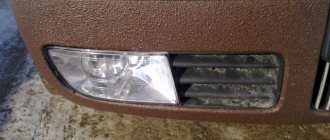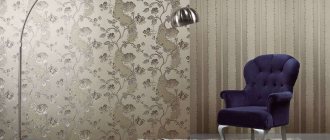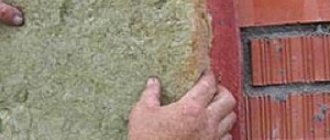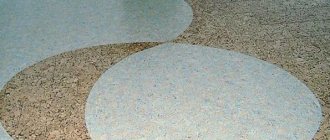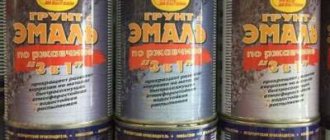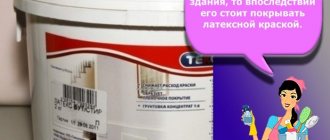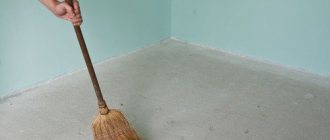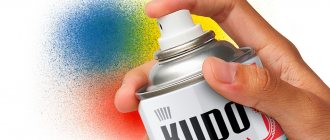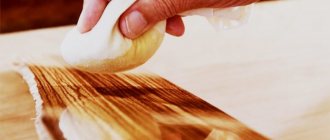Home » Tuning » Painting a car with liquid rubber, all the pros and cons 367
Painting with liquid rubber Plasti Dip is a coating for a modern, stylish car, the rubber composition is mainly bitumen and does not contain harmful volatile substances.
The innovative liquid rubber created by the development engineers has a lot of useful qualities, which attracts consumers on the market.
- applying liquid rubber does not require extensive preparation of the car body
- adhesion of liquid rubber promotes strong adhesion to the applied surface
- The viscosity of liquid rubber allows it to be applied to horizontal surfaces
- The spraying process of a pressure cylinder allows for painting with rubber on all body configurations
The finished, dry surface of the body covered with a rubber compound protects the car from:
- body corrosion
- paint cracks
- protection against small stones and sand
- sun rays
- salt on the roads
- minor scratches
- is anti-vandal coating
Painting a car with Plastidip liquid rubber is not common to every ordinary person, but still every car lover wants to stand out from the boring mass of traffic.
To do this, he uses various techniques, including painting with liquid rubber, tinting windows, applying airbrushing, painting the car in bright colors or installing additional decorative elements (for example, a spoiler).
One of the latest interesting and at the same time simple ways to decorate your car is the ability to paint your car with liquid rubber. Someone will say that there is no fundamental difference between vinyl film and liquid rubber. But this is only until he actually discovers all the advantages of the latter, namely:
1. Characteristics that make it possible to consider the procedure of painting with liquid rubber the most profitable and correct solution are related to its composition. Only two main components can be distinguished: bitumen (its polymers) and water. It is they who endow this material with such properties as:
- — elasticity;
- — shockproof;
- - waterproof;
- — protection from aggressive environmental factors;
- - resistance to both temperature changes and ultraviolet radiation.
- - prevents slipping
- - seamless coating
Neither vinyl film nor ordinary paint can boast such a long list of useful properties as liquid rubber.
What is liquid rubber?
First of all, it’s worth understanding what liquid rubber is. Many hobbyists want to change their car, but without radically repainting it. For this purpose, they came up with vinyl and other methods of quick transformation. One of these is liquid rubber paint. We are talking specifically about rubber-based paint. This structure makes it easy to apply it to the surface, as well as easily remove it, if necessary.
Liquid rubber for cars
This type of coating is used as protection and to quickly change the style and color of a car. The rubber in the composition ensures long-term operation compared to film. Rubber paint is used for cars when completely repainting and changing some parts.
Depending on the application method, you should buy in aerosols and canisters. The price fluctuates depending on the manufacturer and quality.
The colors that liquid vinyl offers do not represent a wide range; there are 6 popular varieties:
- Neon (advantage of an unusually bright color).
- Metallic (impeccable style).
- Chameleon (the color scheme changes depending on the point of view).
- Mother of pearl (shine and play of colors).
- Transparent (the coating does not hide the factory color of the car).
- Thermal (color changes depending on temperature).
Suitable for everyone
Rubber painting is an innovation in the field of car tuning. Thanks to this paint, you will get a perfectly smooth matte surface, which will also resist the formation of corrosion both in frost and at very high air temperatures. The rubber coating is not affected by sunlight in any way, so your car will not have any wrinkles or joints. By the way, you do not need to prepare the car in any way before painting, and if you change your mind, the paint dries quickly and is removed.
Liquid rubber for cars: pros and cons of painting a car with the substance
Of course, the main advantage of covering a car with liquid paint is its protective effect. Vinyl is significantly inferior; liquid film for cars not only hides some defects, but also prevents the formation of cracks, scratches and other damage.
The main advantage of covering a car with liquid paint is its protective effect.
The undoubted advantages include the following properties:
- Creates a protective layer, the paintwork remains intact.
- It has several texture solutions, creating a matte or glossy effect.
- Can be used on the entire body or on individual parts.
- High waterproofness and elasticity.
- Shows resistance to ultraviolet radiation.
- Gives the car impeccable style and status.
- Painting with liquid vinyl is applied to hard-to-reach areas. For example, a tire will look like new after painting.
- There is no need for additional requirements, the complete technology is much simpler.
There are also disadvantages. The main disadvantage is that the service life is maximum 2 years; the first signs of wear appear after a year. In addition, the rubber layer can leave sticky marks and can only be removed by polishing. Another drawback, or rather feature, is the monotony of color. It is impossible to create a drawing or three-dimensional figure.
The main disadvantage is that the service life is maximum 2 years, the first signs of wear appear after a year
Types of rubber paint for cars.
Rubber paint has gained great popularity among many car owners. Taking into account the needs for various materials for covering a car, the range of liquid vinyl is constantly increasing. Currently, there are several main types of rubber paint, each of which includes many color shades. Thus, you can choose liquid vinyl for your car in almost any situation. Types of liquid rubber differ in texture: matte is common and glossy is more rare. Also in rubber paint there are separate groups that include non-standard colors like chameleon, pearlescent or neon.
Matte rubber paint for the car.
Matte rubber paint for cars is in consistently high demand due to its unique qualities. The popularity of liquid matte vinyl is comparable to matte film. The coating formed after application to the surface of the body is indistinguishable from ordinary matte film. At the same time, matte liquid rubber is devoid of many of the disadvantages inherent in roll materials. Liquid matte vinyl looks very unusual compared to standard paintwork.
A matte surface, unlike a glossy one, weakly reflects the sun's rays. This occurs due to the scattering of light on the matte finish. The result is deeper and richer shades. Colors like blue, red, green or orange look much brighter. Due to its low reflection, the matte black color has incredible depth even in sunny weather. Matte liquid rubber not only looks beautiful on the car, but is also extremely practical for everyday use. On a matte surface, various chips or scratches that inevitably appear on any car are less noticeable. In addition, matte liquid vinyl is more resistant to mechanical damage than body paint.
Glossy liquid rubber for car rims.
Glossy liquid rubber is used instead of regular paint. As mentioned above, using liquid vinyl, a glossy surface can be obtained in two ways. The first consists of spraying a base color layer, on top of which is glossy liquid vinyl. This process has its advantages and disadvantages. The need to change liquid paint somewhat reduces productivity, although the matte layer still needs to be allowed to dry, so it’s a stretch to call this a disadvantage. A more significant problem is controlling the uniformity of the glossy layer.
The second way to get a glossy surface is to use a special liquid vinyl, which immediately creates a gloss without additional tricks. There is only one drawback here and it lies in the limited selection of color shades that glossy liquid vinyl offers.
The use of glossy liquid rubber is somewhat different from matte vinyl. The main purpose of glossy liquid vinyl is to paint new or repaired parts, cover rims and change body color. Using liquid glossy vinyl, it is extremely convenient to restore damaged parts at home. For this, aerosol cans with liquid paint are used. Depending on the size and number of parts, from one to three cylinders are consumed. If you plan to paint wheels with liquid rubber , then you need to stock up on a couple of cans of the desired color. Changing the color of a car using balloons, although possible, is absolutely not justified in terms of time and budget. Professional painting with liquid rubber requires special equipment and a non-residential premises in which the body painting will take place. For complete high-quality coverage, two or three buckets of liquid rubber are required.
Transparent liquid rubber on cars.
Transparent liquid rubber is used to create anti-gravel body protection or to cover colored liquid vinyl. Painting a car with liquid rubber provides good protection that is not inferior to film. Transparent liquid vinyl comes in glossy and matte finishes. As an additional layer, glossy rather than matte vinyl is mainly used. To create a protective coating, you can use both glossy and matte transparent liquid rubber.
Glossy transparent liquid vinyl has a number of advantages over conventional anti-gravel vinyl. No matter how skillful the wrapper is, there are some parts of the car that cannot be glued without a joint. Sometimes the seams of the film are clearly visible, which reduces the attractiveness of the car. Transparent liquid vinyl solves this problem completely. Liquid protective film can be used in conjunction with conventional anti-gravel film. Moreover, it is easy to cover the entire body with liquid glossy vinyl. Another advantage of transparent liquid vinyl is the unlimited number of layers, and the more layers there are, the better the protection of the paintwork.
Partial coating of the body with liquid transparent vinyl can be done with your own hands. Parts such as bumpers and fenders are more difficult to cover than the roof, hood or trunk. When using liquid vinyl, it makes absolutely no difference what you cover; it lays equally flat everywhere. The same bumper can be protected from gravel with a single spray of glossy liquid vinyl with just a little time. Other parts that require protection from mechanical damage are covered in a similar manner.
Liquid vinyl chameleon color.
Chameleon-colored liquid vinyl stands out from standard rubber paints in that it can change its color. The hue of chameleon liquid film changes depending on the viewing angle and lighting. If the observer moves relative to the car covered with this liquid vinyl, then the color shades smoothly flow from burgundy and purple to green and blue. The same applies to lighting: a chameleon-colored liquid film will look completely different in bright daylight or at dusk. The main feature of liquid rubber with a chameleon effect is a constantly new color that is never repeated. Impressions from a car covered with chameleon-colored liquid vinyl are only positive. A chameleon-colored car is suitable for both exhibitions and everyday use, since it does not attract too much attention, unlike cars with bright shades of red or green. Chameleon-colored rubber paint is in many cases more convenient than regular film. For example, you can cover a radiator grille with liquid vinyl (especially the mesh), which is difficult to cover with film. It is also better to cover embossed plastic with liquid rubber, since the film will not adhere to such material.
Pearlescent liquid film.
Mother-of-pearl, or, as it is also called, pearl liquid film, belongs to chameleons, that is, materials with a changeable shade. The difference from the chameleon color is that pearls are white with a shimmer of pastel colors, and the chameleon color is dark shades, such as purple, blue, burgundy or green. While chameleon effect liquid film can change color greatly, for example from blue to bronze, pearlescent liquid vinyl always remains white. Pearl rubber paint varies in additional colors: pink-blue, lilac-gold, etc.
Pearlescent liquid rubber is ideal for coating white cars. To paint a white body with pearl liquid vinyl, one or two layers are enough for the chameleon effect to become clearly visible. Of course, you can paint any car mother-of-pearl, but if its color is different from white, then you will have to spend more liters: this will not affect the cost of the material much, but the time costs will increase.
Metallic.
There is a special class of liquid vinyls, the color of which, after spraying onto the surface, acquires a metallic sheen. This is achieved due to microscopic particles added to the main composition of the liquid film. Rubber paint with a metallic effect looks very nice, although it is not suitable everywhere.
The peculiarity of liquid metallic vinyl is that a glossy surface is required for the best manifestation of the effect. That is, after painting the parts in metallic of the desired color, additional application of liquid rubber to obtain a glossy layer, or liquid vinyl should initially be glossy, not matte.
Metallic liquid rubber is well suited for painting rims, and it is not necessary to select the exact shade. If the body styling contains elements made in a certain color, then the wheels can be covered with the same shade or painted in the main body color. In both cases, wheels painted with liquid vinyl with a metallic effect will look beautiful and fit perfectly into the design of the car.
Thermal liquid rubber.
Of all the types of liquid rubber, perhaps the most unusual is thermal. What is meant by the phrase “thermal liquid vinyl”? Painting with thermal liquid rubber occurs in the same way as regular liquid vinyl. Operation is no different either. Thermal rubber paint has the ability to change color at different temperatures. At normal temperatures, for example 25 degrees Celsius, the liquid film has one color, but as soon as the temperature rises, the shade changes. The easiest way to notice this is to pour a glass of hot water on a car painted with liquid thermal vinyl. At the same time, in places where water has entered, the color will change dramatically. Colors can change both in shades (blue - light blue) and completely different colors (green - purple). This feature makes thermal liquid rubber the most unusual material for coating car body parts. In addition to aesthetic applications, thermal liquid rubber for cars has purely practical functions. If you paint certain parts with this paint, you can visually control the temperature, which is extremely necessary in many cases.
Neon rubber car paint.
Neon rubber paint is essentially a regular matte or glossy liquid vinyl, except for two things. Firstly, neon liquid rubber has an incredibly bright, acidic color. Secondly, in order to obtain such saturation and brightness, the car must initially be white. Alternatively, the car body is first covered with white liquid vinyl, over which neon is applied.
When covering your car with a liquid film of neon shades, you need to be prepared for the close attention of others. Even at dusk, a car painted in neon color looks very bright and attractive. Fans of external tuning cover their wheel rims with neon shades of liquid rubber: this requires a couple of cans of paint. Liquid vinyl in bright colors can be applied to the surface without prior coating with white, but the result will not be so impressive. There are several bright neon colors of rubber paint available.
- Blue neon liquid vinyl.
- Orange neon rubber paint.
- Bright green liquid rubber.
- Hot pink liquid vinyl.
- Purple liquid rubber in a neon shade.
- Red neon liquid vinyl.
- Yellow-green shade of rubber paint.
Technology of coating a car body with liquid rubber
The complete painting process takes several hours, followed by a day of drying. It all depends on where the liquid rubber is used, whether the entire car will be covered or only parts of it. The technology is not complicated and consists of several stages:
- Preparing the car. Talk about washing, cleaning and priming, if necessary. It is worth understanding that complete rubber coverage completely hides all defects.
- Hiding elements that will not be painted. They must be removed or sealed with tape.
- Rubber application. How long it will last depends on the method of application.
- Drying. It takes at least a day. Until this time, the machine cannot be used - it may disrupt the entire process.
It is important to adhere to safety rules when carrying out painting work. A respirator, gloves and no open fire are required.
You can actually do the painting yourself or use the services of specialists. This requires additional funds, but the result will be impeccable.
General conclusion
Installing a roof using elastic material is not a complicated process. Choosing a suitable rubber coating based on the main parameters is also not difficult. But there are certain nuances. For example, which liquid roofing manufacturer to choose, where to get spraying equipment and from whom to learn how to work with it. Therefore, it is better to turn to professionals who will select the optimal solution and do all the work in compliance with technology requirements.
Ratings 0
Preparing a car for painting with liquid rubber
One of the main points is preparing the car for painting. First, it must be cleaned, washed, and when drying has occurred, a mandatory step is degreasing. A similar process is necessary so that the material lays evenly on the car and bubbles do not appear.
Preparing a car for painting with liquid rubber
If there is serious damage, it must be hidden with a primer. An important point: after applying it, it is not advisable to paint it. All defects will be hidden under the rubber.
The next stage of preparation is to dismantle the parts that will not be painted. First you need to remove the license plates, windows and headlights. If paint will not be applied to some parts, but they are difficult to remove, they should be sealed with a special film. But it needs to be done very carefully. Place special emphasis on windows.
Let's move on to the wheels, if painting them is in the plans, then masking tape should be used on the brake drums. If the discs will not be painted, they need to be wrapped in a tight film or painted in the removed position.
Preparing the car. the washing up
Like any other work, covering with liquid rubber requires special preparation of the car before work.
We wash the car like for a wedding, even better
You need to wash the car very well and dry it completely. To do this you need to at least use compressed air and a hair dryer.
Drying is very important, as any moisture that remains on the surface of the body will interfere with the uniform application of the rubber.
In addition, adhesion to the surface may not be as good, or small bubbles will appear on the surface of the liquid rubber. And, over time, they will turn into spots. So, you need to dry everything with a hairdryer with special care.
Pay attention to the places under the handles and rubber bands, on the mirrors, under the hood, doorways, and so on.
In addition, if you plan to also paint doorways, then the procedure must be repeated again with greater care in the areas of the inner door space. Everything there should be well washed, degreased, and dirt should be completely removed.
Protecting the interior from paint exposure
After all the procedures described above, the doorway is carefully sealed so that the paint does not penetrate into the interior. In addition, you will also have to seal the door, along with the glass and cards. In short, protect all areas that are not going to be painted.
Preparing liquid rubber and spray for painting
In order for the painting to be successful and the result to be impeccable, it is worth choosing the right equipment. An important element is the choice of paint itself - the basis of the entire process. You can buy it ready-made, but the thick consistency is not suitable when applied to a surface. Additional solvent required. It can also be purchased complete with paint. It is very simple to prepare the solution: you need to mix the paint with the solvent in a 1:1 ratio and stir until a homogeneous mass is obtained. All necessary instructions are indicated on the packaging.
A special automotive spray gun is used for painting. Fill the prepared solution only up to half. Particular attention should be paid to the filter.
Spray gun for liquid rubber DeVilbiss PRi Pro Lite
Cons and classifications
Disadvantages of the material:
- Seamless sprayed waterproofing is susceptible to solvents made from petrochemical products;
- The unique degree of adhesion will affect the difficulty of dismantling, when removing a dense layer quickly will not be possible;
- The high cost of liquid rubber is often a turn off, and buyers order roll products.
For large volumes of work, it is advisable to use special equipment. But purchasing the device will require additional costs.
The classification of liquid rubber is related to physical properties. The material is divided into 4 categories:
- Aerosol. Sold in small bottles and allows you to quickly repair damaged areas.
- Painting. The thick consistency is applied manually using a roller or paint brush;
- Sprayable. The spraying process occurs quite actively using a mechanical device, and with intensive mixing in the installation: hardener, water-salt solution and bitumen mastic.
- Bulk. It is formed before starting work and poured onto the surface.
The fourth material is characterized by its low cost.
Applying liquid rubber to a car
Any type of painting can leave marks on human skin, so be sure to use protective clothing. Moreover, all areas of the body must be covered. Wear wide glasses and a respirator. Only people wearing such equipment should be in the room.
Painting starts with the big details. First the hood, roof, doors, then difficult areas. The technology involves parallel application of paint to the car in layers, the distance should be 15 cm. In order to improve fixation, it is better to make the first layer thin. There are only 10 layers, there are options for applying less, but then the quality suffers.
The layers must be applied slowly, after each layer drying is required for 20 minutes. After applying the last coat, leave the car to dry indoors for 24 hours. The temperature is not so important, but it is better not to be very hot. The temperature is often maintained at 18-20 degrees in the absence of drafts. Remove protective stickers only after complete drying. Carefully remove the film and tape, cutting at the joints with a knife.
Helpful Tips:
- Carry out the dyeing process in a dry room. Each layer of paint must dry naturally, so the air temperature must be high enough.
- Each layer dries in about 15 minutes, without speeding up the process with a hairdryer or other mechanical devices.
- To protect your body, be sure to wear a protective suit and a respirator.
- It is recommended to spray paint at medium speed
- If the surface of the car has uneven surfaces and corrosion, sand and fill such areas to prevent unevenness.
- Complete hardening of the paint will occur after 10 - 16 hours from the moment of painting
Approximate consumption of liquid rubber when painting
This paint is a very expensive material, so car enthusiasts are interested in the cost of painting and how much it costs. It all depends on the type of paint chosen and the specific car. Consumption is indicated on the packaging for full coverage, but not more than 7 layers. Usually this is not enough, so the dose should be slightly exaggerated.
You can fully calculate the consumption with the help of specialists. You will need the characteristics of the car.
Applying liquid rubber to a car
Recommendations for applying paint
How to apply this paint to a car? Lining with liquid rubber should be done in several layers. Their number depends on differences in body tone and the chosen dye. First of all, a white base is applied. The main working tool for painting is a paint sprayer.
The spray gun must be held at an angle of 90 degrees to the structure being treated. First, only 2-3 layers of material are applied with a painting tool.
If the car is being fully trimmed, it is best to start work from the rear right side, then the roof and the rear left side are processed. After this, work is carried out on the roof and rear bumper. The next parts that need painting will be the left side of the body and the left side of the hood. Next, the radiator grille is processed. A gradual transition is made to the hood and the right side of the car is painted.
The base paint layer will need to be given a translucent tone. After treatment, you need to wait about 15 minutes so that the composition has time to dry. Then the rubber dye is reapplied, the number of layers should be about 5. The last layer should dry for at least an hour.
Important! Experts do not recommend using heat guns or other equipment to speed up the drying process of paint.
As you can see from the article, liquid rubber is an excellent solution for painting a car. It has excellent protective properties, and the work of applying and removing it is not difficult. If strong mechanical pressure is applied to the rubber, it will be quite difficult to damage the coating. The cost of production is at a fairly acceptable level - 300-500 rubles, which is also a very important factor.
Instructions for painting a car with a spray gun (2 videos)
Rubber paint from different manufacturers (35 photos)
Consumption of liquid rubber in aerosol cans
As for liquid rubber in aerosols, the consumption will depend on the scale and area of painting. It is worth mentioning that spray cans are rarely used in case of complete painting; they are convenient for finishing small parts, for example, tires. But there are cases when aerosols are used over the entire area of the car.
The calculation occurs according to the following scheme:
- Large elements such as the hood, roof and trunk each have 2 cans.
- Smaller parts, for example, doors are best painted using 1 aerosol.
Thus, a complete painting requires approximately 15 cans.
Payback
The numbers above show that the payback will occur after the first order is completed. The initial costs for equipment/paint/premises will be approximately 12-15 thousand rubles. That is, you will start receiving net profit from the second order.
What can we say about profitability? It is incredibly high, so painting a car with liquid rubber is an extremely profitable business. And it’s worth starting now, before competitors appear.
Consumption of liquid rubber concentrate for car painting
If you use a concentrate, painting is done using a spray gun. A car of class A and B - you will need from 3 to 5 liters, class C and D - up to 7 liters, class E, F, S - up to 12 liters. These are approximate figures, they are indicated based on the application of no more than 7 layers of rubber. In addition, there is a difference depending on the radicalness of the repainting. If the factory color is dark and dark rubber is applied, then less paint will be needed. In case of a radical change in color, additional layers are required, and therefore more paint.
Liquid rubber in a can
Comparison table of characteristics
We compared the characteristics of modern liquid rubbers in a general table.
| Model | Volume, ml | Weight, g | Type of equipment | Manufacturer country |
| ASTROhim | 520 | 345 | Cars, Motorcycles | Russia |
| RUNWAY | 450 | 450 | All | China |
| DECO FLEX | 520 | 365 | All | Russia |
| Larex Black | 520 | 311 | All | Russia |
| 1NEW Liquid Rubber | 400 | 283 | All | China |
| ColorFlex | 520 | 520 | car, motorcycle, bicycle and other equipment | Russia |
| Rubber Paint | 1000 | 400 | automotive industry and more | Russia |
Review of car painting with Plasti Dip liquid rubber
On popular Internet pages, you can find many reviews about Plasti Dip liquid rubber. Luxury car lovers are happy to share their impressions.
Egor: “This paint is a wonderful thing, the pros and cons are visible the first time you use it. It is worth saying that there are more advantages. I decided to start small and applied paint to the rim grilles. The car was immediately transformed. The paint is very easy to apply. The only downside is the rather high cost.”
Karina: “I wanted my swallow to stand out from the cars in the crowd, so I chose liquid vinyl. I was completely satisfied with the result. Just a day later I received a completely new car, I chose the bright Plasti Dip color. The native red is not visible. The only negative I can say is that after a year, namely in the middle of summer, the color began to lose its brightness.”
Valentin: “Plasti Dip was recommended at the salon. They assured that the material is durable, the coating is stylish and unique. I chose a metallic color with a glossy structure. The car came out great. I think that everyone can choose their own individual style. After 20 months, I removed the coating on my own without any extra effort. There were no marks or scratches left on the car.”
Car tire painting technology
Car wheels can rightfully be called one of the most important parts of a vehicle, especially for sports cars, where tires and a uniform design of the wheel structure become a distinctive design component. If you want to profitably transform your vehicle, then the first question you should ask yourself is what to paint the tires with?
There is a wide variety of tire paints, tire paints, and other similar items available in the market today. If you cannot find such compounds in your city, you can always contact a specialized center that offers services such as painting and car tuning.
The process of painting wheels can be divided into two main stages:
- Painting wheels.
- Tire painting.
Let's take a closer look at the second stage, since this is where many problems arise:
1. Tire inflation. Before painting the rubber, the tires must be inflated to working condition.
2. Cleaning the surface to be treated. The area that needs to be painted must be cleaned of dirt and degreased with a special product (White spirit, universal degreaser).
3. Selection of painting areas. If you plan to paint a specific area of the tire, use tape to hide other areas.
4. Applying paint. First, decide which tool will be more convenient for you to work with (brush, roller or spray gun). Spray paints are also available for sale; they are much more convenient to work with, but the material consumption is greater. Before applying, it is recommended to heat the paint a little so that it applies more evenly. There should be at least two or three layers.
5. Drying
It is important to leave the tire to dry after applying each layer for about 24 hours; only after the previous one has completely dried, a new layer is applied. After the final coating, the product can be put into use within 24 hours
How to apply
The mastic in question can be applied in several ways:
- Spraying method. It is this method that allows you to obtain the highest quality and durable coating. In addition, this method is the least labor-intensive and at the same time the fastest. Therefore, when performing waterproofing on an industrial scale, spraying is used. The only negative is that spraying mastic requires special, expensive equipment. Therefore, if you want to do waterproofing yourself, this method is not suitable for you;
- By painting . The simplest method, the essence of which is to apply mastic with a brush, roller or spatula. The disadvantage of this method is the labor intensity of the work and the low speed of coating application;
Mastic can be applied to vertical surfaces with a brush or spatula.
- Bulk method . In this case, the mastic is simply poured onto a flat surface and then leveled. In this way, you can quickly and easily cover the surface with waterproofing. The disadvantage is that only horizontal planes can be processed in this way.
